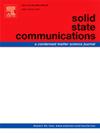集体中性激发作为超纯砷化镓量子阱中二维电荷载流子系统质量的灵敏探针
IF 2.1
4区 物理与天体物理
Q3 PHYSICS, CONDENSED MATTER
引用次数: 0
摘要
超洁净的低维相互作用电荷载流子系统是探索相关态和相的基础。我们报告了在高质量砷化镓量子阱结构中观察到具有超高迁移率的二维电子系统(2DES)的非常窄的集体带间激发(ISBE)。这些来自共振非弹性光散射(RILS)实验的发现被用作探索高完美度二维电子系统中传输迁移率与集体电子行为之间联系的工具。我们发现,集体 ISBE 模式的线宽可以非常窄,小于 80 μeV。通过比较几个高迁移率样品的 ISBE 测量结果,我们发现线宽的变化超过 2 倍。然而,令人惊讶的是,在 15×106cm2/Vs≤μ≤24×106cm2/Vs 的范围内,ISBE 线宽与迁移率之间缺乏直接相关性。通过 RILS 对 ISBE 进行了讨论,认为它是表征相互作用电子系统的灵敏探针,可用于分数量子霍尔效应 (FQHE) 研究。本文章由计算机程序翻译,如有差异,请以英文原文为准。
Collective neutral excitations as sensitive probe for the quality of 2D charge carrier systems in ultra-pure GaAs quantum wells
Ultra-clean low-dimensional interacting charge carrier systems are the basis to explore correlated states and phases. We report the observation of very narrow collective intersubband excitations (ISBE) of 2D electron systems (2DESs) with ultra-high mobilities in high quality GaAs quantum well structures. These findings from resonant inelastic light scattering (RILS) experiments are used as tools for exploration of links between transport mobility and collective electron behavior in 2DES of high perfection. We find that the linewidths of collective ISBE modes can be very narrow with values smaller than 80 μeV. Comparison of ISBE measurements from several high-mobility samples exhibits a variation in linewidth of more than a factor of two. There is, however, a surprising lack of direct correlation between ISBE linewidth with mobility in the range . ISBE by RILS are discussed as a sensitive probe to characterize the interacting electron systems for fractional quantum Hall effect (FQHE) studies.
求助全文
通过发布文献求助,成功后即可免费获取论文全文。
去求助
来源期刊

Solid State Communications
物理-物理:凝聚态物理
CiteScore
3.40
自引率
4.80%
发文量
287
审稿时长
51 days
期刊介绍:
Solid State Communications is an international medium for the publication of short communications and original research articles on significant developments in condensed matter science, giving scientists immediate access to important, recently completed work. The journal publishes original experimental and theoretical research on the physical and chemical properties of solids and other condensed systems and also on their preparation. The submission of manuscripts reporting research on the basic physics of materials science and devices, as well as of state-of-the-art microstructures and nanostructures, is encouraged.
A coherent quantitative treatment emphasizing new physics is expected rather than a simple accumulation of experimental data. Consistent with these aims, the short communications should be kept concise and short, usually not longer than six printed pages. The number of figures and tables should also be kept to a minimum. Solid State Communications now also welcomes original research articles without length restrictions.
The Fast-Track section of Solid State Communications is the venue for very rapid publication of short communications on significant developments in condensed matter science. The goal is to offer the broad condensed matter community quick and immediate access to publish recently completed papers in research areas that are rapidly evolving and in which there are developments with great potential impact.
 求助内容:
求助内容: 应助结果提醒方式:
应助结果提醒方式:


